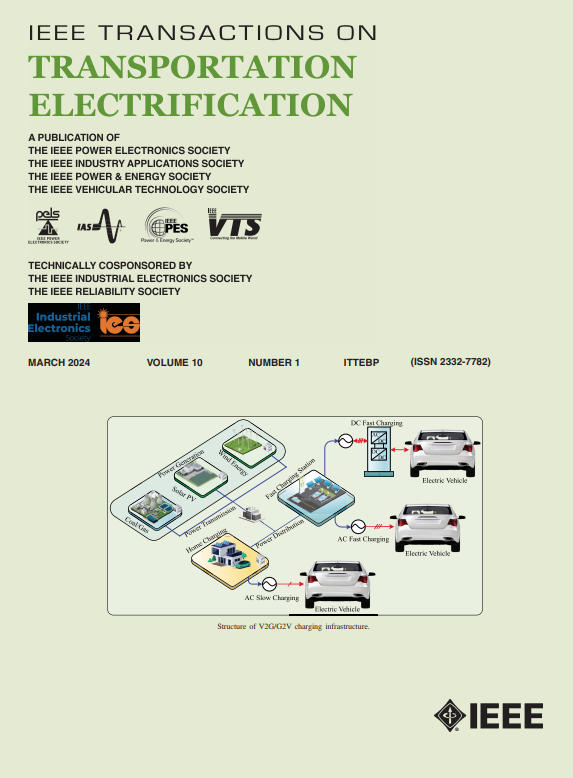简化MTPA集成基于虚拟电压矢量的MPCC,提高基于IM驱动的电动汽车的性能和效率
IF 8.3
1区 工程技术
Q1 ENGINEERING, ELECTRICAL & ELECTRONIC
IEEE Transactions on Transportation Electrification
Pub Date : 2024-12-11
DOI:10.1109/TTE.2024.3515138
引用次数: 0
摘要
本文介绍了一种节能、低计算负担的方法,即基于占空比的虚拟电压矢量模型预测电流控制(V3MPCC)与基于感应电机的电动汽车(ev)的最大转矩每安培(MTPA)控制相结合。传统的MPCC (C-MPCC)在每个控制周期采用单个电压矢量,导致显着的转矩波动和大电流。该方法采用占空比控制,结合零矢量,减少虚拟矢量的活动时间,以减少虚拟矢量增多带来的计算负荷。为了减小控制误差,提高系统效率,引入了虚拟矢量。在MTPA条件下,与传统方法相比,在保持动态性能和扩大转速运行范围的同时,制定了与定子磁链在基本转速上下均成正比的占空比。其目的是在不增加开关频率的情况下减小转矩纹波,降低定子电流总谐波畸变。广泛的测试,包括分析扭矩脉动和功率损耗,证实了这种方法在ECE-Extra Urban Drive Cycle条件下的优势。这种方法具有显著的优势,如提高电机效率,改善动态性能,减少计算负担。本文章由计算机程序翻译,如有差异,请以英文原文为准。
Simplified MTPA Integrated Virtual Voltage Vector-Based MPCC for Improved Performance and Efficiency in IM Drive-Based Electric Vehicles
This article introduces an energy-efficient, low computational burden approach called duty ratio-based virtual voltage vector-based model predictive current control (V3MPCC) combined with maximum torque per ampere (MTPA) control for induction motor-based electric vehicles (EVs). Conventional MPCC (C-MPCC) employs a single voltage vector per control cycle, leading to significant torque ripples and high current. The proposed method uses duty ratio control, incorporates a zero vector, and reduces the time of active virtual vectors to minimize the computational load that comes with more virtual vectors. Virtual vectors are introduced to reduce control errors and improve the efficiency of the system. A duty ratio proportional to stator flux both above and below base speed, using MTPA condition, is formulated to minimize stator current errors while maintaining dynamic performance and expanding speed operating range compared to traditional methods. The aim is to reduce torque ripple and lower stator current total harmonic distortion (THD) without increasing the switching frequency. Extensive testing, which includes analyzing torque ripple and power loss, confirms the advantages of this approach under ECE-Extra Urban Drive Cycle conditions. This methodology delivers significant advantages, such as enhanced motor efficiency, improved dynamic performance, and reduced computational burden.
求助全文
通过发布文献求助,成功后即可免费获取论文全文。
去求助
来源期刊

IEEE Transactions on Transportation Electrification
Engineering-Electrical and Electronic Engineering
CiteScore
12.20
自引率
15.70%
发文量
449
期刊介绍:
IEEE Transactions on Transportation Electrification is focused on components, sub-systems, systems, standards, and grid interface technologies related to power and energy conversion, propulsion, and actuation for all types of electrified vehicles including on-road, off-road, off-highway, and rail vehicles, airplanes, and ships.
 求助内容:
求助内容: 应助结果提醒方式:
应助结果提醒方式:


